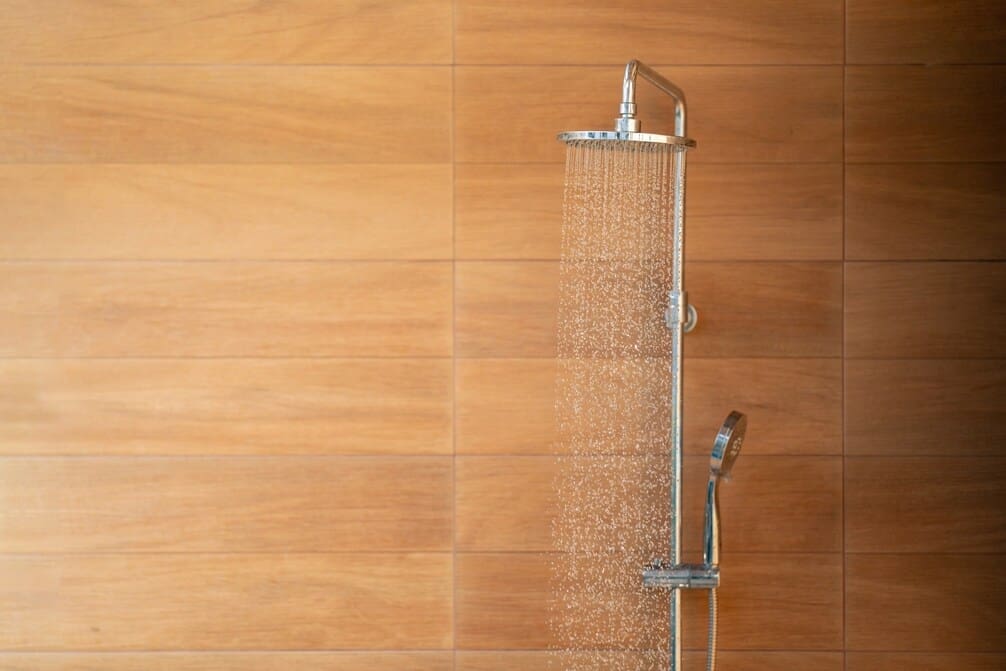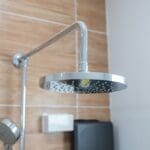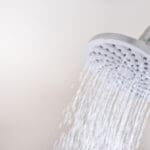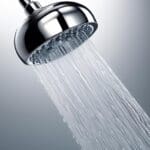You might not be aware, but the annoying whistling noise emanating from your shower head could actually be a sign of underlying issues you’ve overlooked.
If you’ve noticed a high-pitched sound every time you turn on the shower, it’s likely due to a range of factors, from a loose connection that lets air and water mix to high water pressure that forces water through constricted spaces, creating vibrations.
Other culprits could include worn-out washers or even a small crack in the shower head itself.
While tightening the connection or replacing a washer might seem like straightforward solutions, understanding the exact cause is crucial for a lasting fix.
Key Takeaways
- Loose shower head connection can cause whistling noise, check for gaps and reattach securely.
- High water pressure can cause whistling noise, consider installing a water pressure regulator.
- Worn-out washers may lead to whistling noise, replace them to prevent water leakage.
- Damaged shower heads or clogs can cause whistling noise, clean or replace as needed.
Identifying Loose Shower Heads
A loose shower head, often the culprit behind that annoying whistling noise, can usually be identified by a few straightforward signs. If you’re hearing a high-pitched whistling sound every time you turn on the water, it’s likely due to a connection issue between the showerhead and the pipe. When the shower head isn’t properly screwed or tightened, water leaks out, forcing air through the line and creating that distinctive sound.
To fix this issue, first, check the connection point. If you notice any gap or movement, it’s time to reattach the shower head more securely. Using a wrench or pliers, gently tighten the showerhead onto the pipe. Be careful not to overtighten, as this could damage the threads. Giving the head an extra quarter turn should suffice to stop the leaking or whistling.
In some cases, you may need to remove the showerhead to inspect it for damage or to clean any debris that might be obstructing water flow. Reattaching it securely afterward should eliminate any whistling sound and restore a peaceful shower experience.
High Water Pressure Issues
Experiencing a piercing whistling sound during your showers often points to high water pressure issues, which can be both annoying and harmful to your plumbing system. This whistling noise indicates that the water pressure in your pipes is too high, causing the water to vibrate as it passes through, creating that high-pitched sound.
To solve the problem, first, consider installing a water pressure regulator. This device can help reduce the water pressure to a safer level, thereby eliminating the whistling noise. Additionally, cleaning the aerator on your shower head can remove mineral and debris buildup, which might be exacerbating the high water pressure issues.
If your shower is making a whistling noise even after these steps, it may be time to replace your shower head with one designed to handle high water flow. This can accommodate the high pressure without causing the whistling.
However, if these solutions don’t rectify the problem, it’s wise to consult a professional plumber. Persistent high water pressure issues can damage your plumbing system and the water supply lines, so it’s crucial to address the cause properly. A professional can assess and fix the issue, ensuring your showers are peaceful and your plumbing is safe.
Washer Replacement Necessity
Among the common causes of a whistling shower head, worn-out washers often necessitate immediate replacement to prevent water leakage and eliminate the noise. This irritating sound can disrupt the peaceful ambiance of your shower, turning it from a relaxing experience into a source of annoyance. It’s crucial to address this issue promptly.
Here are steps to guide you through washer replacement:
- Turn Off the Main Water Supply: Ensure you shut off the main water to prevent any leaks or spills during the process.
- Disassemble the Shower Valve: Carefully remove the handle and trim to access the valve. This will expose the washers that need replacing.
- Inspect and Replace the Washer: Look for signs of wear or damage on the washer. If it’s compromised, replace it with a new one that matches the size and type.
- Reassemble and Test Your Shower: After replacing the washer, reassemble the shower valve, turn the main water back on, and test the shower for any signs of whistling or leakage.
Addressing the underlying issue of a whistling shower head by replacing worn-out washers not only stops the noise but also helps in maintaining the integrity of your shower’s hot and cold water balance, ensuring a pleasant and leak-free experience.
Detecting Shower Head Damage
After addressing the issue of worn-out washers, identify any damage to your shower head that might be causing whistling noises. A loose connection or improperly screwed shower head often leads to a whistling or squealing sound. Ensure it’s correctly tightened to mitigate this issue.
High water pressure can also culminate in a shower whistling, suggesting the installation of a water pressure regulator or cleaning the aerator to moderate the flow.
Furthermore, a clogged shower head, hose, or pipe restricts water flow, producing a whistling sound when hot or cold water is forced through. Hard water contributes to mineral buildup; soaking the shower head in a heavily diluted solution of white vinegar can effectively dissolve these deposits and restore normal flow. Regular cleaning is essential to prevent future clogs.
Inspect your shower head for any holes or cracks, as these imperfections can alter the sound of your shower, turning the flow into a whistle. If damage is found, replacing the shower head with a more durable one is advisable.
Clearing Clogs and Obstructions
To effectively tackle a whistling shower head, start by clearing any clogs or obstructions in the system. Often, the culprits behind a whistling noise are build-ups that restrict water flow, causing pressure to build up and create that high-pitched sound. Here’s a simple, step-by-step guide to help you eliminate these blockages:
- Remove the Shower Head: Unscrew the shower head from the shower arm. This gives you direct access to inspect and clean out any debris that might be causing the whistling.
- Check the Shower Arm: Before reattaching the shower head, inspect the shower arm for any obstructions. Sometimes, the problem isn’t with the shower head but with the arm itself.
- Clean or Replace Shower Valves: Clogged shower valves can also cause a whistling noise. If you’re comfortable with plumbing, check these valves for any signs of blockage. Cleaning or replacing them might solve the issue.
- Flush the System: With the shower head removed, turn on the water to flush any remaining debris from the shower arm. This will ensure a clear path for water flow, potentially eliminating the whistling noise.
Frequently Asked Questions
How Do I Stop My Shower Head From Whistling?
To stop your shower head from whistling, tighten loose connections, clean or replace the aerator, swap out worn washers, fix any cracks, and unblock clogs. Installing a water pressure regulator may also help.
Why Is My Shower Making a High-Pitched Sound?
Your shower’s high-pitched sound likely stems from issues like loose connections, high water pressure, worn-out washers, or clogs. Fixing these can silence the noise, ensuring a more peaceful shower experience for you.
Why Does My Bathroom Make a High-Pitched Whistling Sound?
Your bathroom’s high-pitched whistling sound likely stems from issues like loose connections or high water pressure affecting your shower head. Fixing it may involve tightening connections or installing a water pressure regulator.
Why Does My Bathtub Faucet Make a High-Pitched Sound?
Your bathtub faucet’s high-pitched sound could be due to high water pressure, a loose connection, worn-out washers, or a clog. Checking and fixing these issues should stop the whistling.





